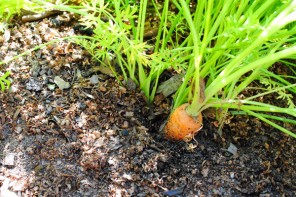The Bamboo Bike Project
Article by: Janine Erasmus
The bicycle is the most available and reliable type of transport in many parts of Africa, used for everything from moving house to taking the sick to hospital. The Bamboo Bike Project aims to help more people become mobile, using bikes built, as its name suggests, from bamboo – an abundant and sustainable resource. In the process it will stimulate a bike-building industry, generating income and boosting local economies.
Craig Calfee of Calfee Design, a California-based company that makes hi-tech racing and mountain bikes for professional cyclists, came up with the idea of the bamboo bike when he visited Africa in 1984. Most people in the areas he visited relied on bicycles to get around, because they were the most practical and affordable mode of transport, given the state of the roads and the limited income of most households.
The bicycles used were imported and designed for well-paved, smooth roads – rare in rural Africa. And Calfee saw that neither bicycles nor roads were in sufficient supply.
An Abundance Of Bamboo
Calfee also noticed that bamboo, a member of the grass family, grew prolifically in equatorial Africa. Bamboo is both flexible and extremely strong, and Calfee, who always uses innovative materials for his bike frames, though it would be ideal for bike construction.
According to the expert bike-builder, a bamboo frame is similar to an aluminium one in both stiffness and weight. Bamboo’s vibration-damping characteristics are closer to carbon fibre, but it absorbs a lot more vibration from an uneven road.
And if people were taught to build the bicycles locally there would be great potential for employment, not only from a thriving bike-building industry but because transport in developing countries often helps create employment. With goods moving more easily from source to vendor, regional trade would be opened up.
The raw material would be freely available and wouldn’t need industrialisation for its exploitation, so non-industrialised communities would benefit too. Only a few parts would need to be imported – Calfee estimated that a container with a capacity for 500 complete bicycles could hold parts for 2 000. The bamboo frame construction and final assembly would be done locally.
One benefit was that a supply of electricity and availability of power tools would not be needed, although access to power would speed up the rate of production. Otherwise all that was required were hand tools and a quantity of resin and sisal fibre.
Setting The Wheels In Motion
In 1996 Calfee put posted a small item on his cycle website asking for interested parties to contact him. The first to respond was David Ho of the Earth Institute, a non-profit organisation, based at New York’s Columbia University, which promotes sustainable development in developing countries. Ho, himself a cyclist, was instrumental in arranging a grant for a feasibility study in Africa in mid-2007.
The study was conducted in Accra, Ghana, where bicycles are in extensive use – doctors, for example, use them to distribute medicine. The local population was keen to try out the single prototype cycle that the bamboo bike team brought with them. Training sessions were conducted in manufacturing techniques, and the locals picked up the necessary skills easily. The project was going well.
Bicycles For The New Millennium
Having studied transport problems in poor rural areas such as western Kenya, the International Forum for Rural Transport and Development recommends bikes as a solution.
Ho said a particular focus of the project would be the special needs of women, who are often the backbone of the community: tending crops, taking care of chores, family life, and finances – and needing transport.
“The bicycle is very important for the lives of poorer rural communities,” said John Mutter, deputy director of the Earth Institute, “Our purpose here is to try to stimulate the idea of building bicycles from a native product, bamboo. The idea is both that we can build a better bicycle than what´s available here now and importantly it can be built locally out of local products.”
The Earth Institute plans to introduce the bamboo bicycles in their Millennium Villages in Africa to test their effectiveness in the field in a controlled environment. The Millennium Villages project uses scientific advances to work with rural African communities help them lift themselves out of extreme poverty, using agriculture, health, education and infrastructure.
The project falls under the Millennium Development Goals, an initiative spearheaded by the UN to reduce poverty and improve the lives of millions of people in developing nations by 2015.
“These bikes can be built in Africa, for Africans, by Africans and hence can become the kernel of an African bike building industry that will satisfy local needs with local products,” Mutter said.
The team is now fine-tuning the manufacturing process and identifying the village in which the bikes will be introduced. “For the initial project, we might use Sauri, Kenya, as our rural bamboo bike trial location,” said Calfee. “Starting the rural trial in the Millennium Villages will facilitate, or at least alleviate, some of the administrative and organisational challenges associated with implementing bamboo bikes in rural Africa.”
The Wonder Plant
Bamboo’s natural properties are impressive – because it absorbs water faster than most plants it is used in some parts of the world for cleaning sewage. It absorbs toxic heavy metals and could be used to clear polluted waters. Some species of bamboo absorb as much 12 tons of atmospheric carbon dioxide per hectare, making them a good weapon in the fight against global warming. Bamboo is the fastest growing plant in the natural world – some species grow by up to a metre in a single day. Bamboo shoots, rich in vitamins and low in fats and carbohydrates, are food for millions of people around the world.
Bamboo poles are the strongest and lightest natural material known to humankind. They can be used in construction to replace both hardwood and softwood. The plant matures in just three years and can be harvested every two years thereafter, so its use in the bike project sustainable as it replenishes quickly.
In Africa, the World Agroforestry Centre is promoting the increased use of bamboo for other purposes, through a pilot project in Kenya and Tanzania, partnered by the Kenya Forestry Research Institute and the Jomo Kenyatta University of Agriculture and Technology. To this end it has introduced the giant bamboo (Dendrocalamus giganteus) into selected pilot sites in Kenya and Tanzania. The fast-growing bamboo plantations will also supplement the region’s over-exploited timber forests, which are struggling to keep up with demand for building timber, fuel for boilers, and material for paper-making.




